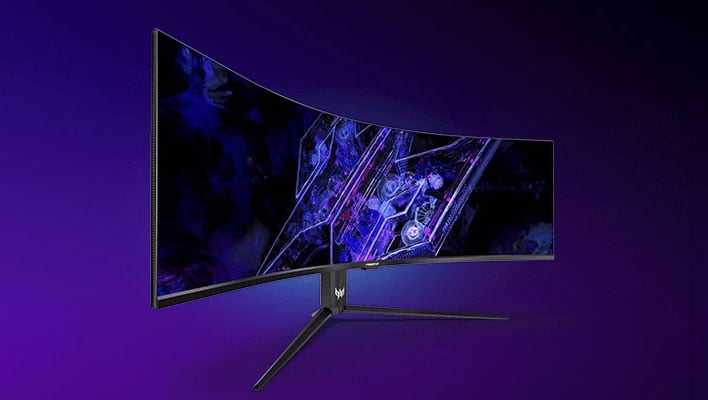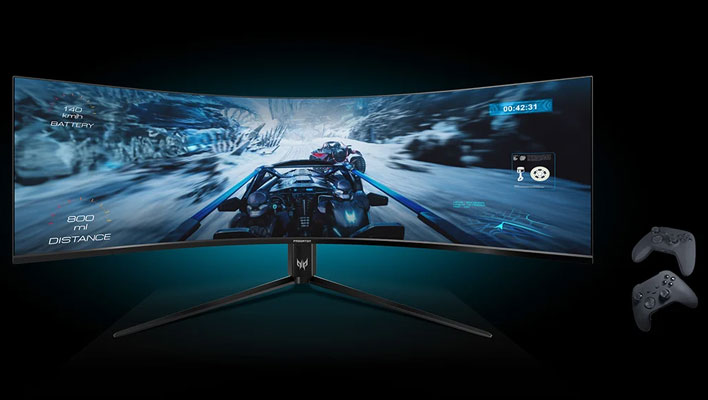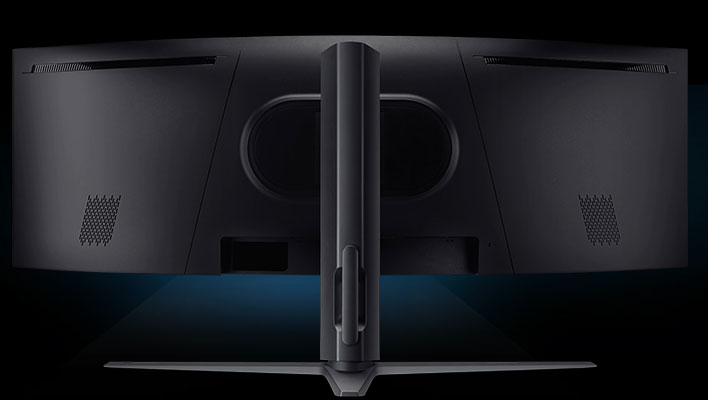Acer's 57-Inch Predator Z57 Mini LED Gaming Monitor Is Here To Prove Size Matters

Look, if you're rocking a 49-inch monitor for your PC setup, then your battle station display is anything but puny. But plop it next to Acer's new Predator Z57? Well, that's about the only thing on the market that might make a 49-inch display feel small by comparison. As the model name implies, the Predator Z57 (first teased at CES) is making a literally big entrance in retail with a bodacious 57-inch curved panel.
The sheer size of the Predator Z57 is enough of an attention-grabber by itself, but Acer's gone the extra mile by outfitting it with mini LED backlighting. That means exceptional brightness, which in this instance amounts to a peak of 1,000 nits. It's also DisplayHDR 1000 certified and purportedly offers 98% coverage of the DCI-P3 color space. So at least on paper, it's massively big, exceptionally bright, and impressively accurate.

"Compared to a regular LED display, Mini LEDs use a larger number of smaller lights to increase the amount of local dimming zones, resulting in granular control over the backlight. This translates to improved brightness levels, color output and contrast. Darks will appear darker, and brights will appear brighter, elevating viewing and immersive gaming experiences to a new plateau," Acer explains.
Those mini LEDs measure a scant 0.008 inches, or 200 microns. In addition to helping boost brightness levels, this allows for more pinpoint control of what parts of a scene to light up, reducing what's known as blooming or the halo effect. That's when lighting spills out from a image and it's most noticeably when there's a bright object (like white text) on a dark scene.

As it relates to pinpoint accuracy, the Predator Z57 boasts 2,304 local dimming zones. It also features a 7680x2160 resolution (32:9 aspect ratio), 120Hz refresh rate, built-in dual 10W speakers, two HDMI 2.1 ports, a single DisplayPort 1.4 input, a 90W USB-C port with power delivery, and a built in KVM switch. That resolution, by the way, is like having dual 4K displays.
This is a FreeSync Premium display as well, so about the only thing missing besides the kitchen sink (and DisplayPort 2.1) is official G-Sync compatibility. That' doesn't mean it won't work with G-Sync, but your mileage will vary (and we haven't spent any hands-on time with this monitor to offer any anecdotal impressions).
Expect to pay a premium for the Predator Z57—Acer's product page has it listed for $1,999.99. We're not seeing it at places like Amazon or Newegg yet, so we'll have to wait for retail listings to emerge to see if street pricing comes in any lower.
Pricing will be key, because as much as we're intrigued by a ginormous mini LED display, 49-inch models are more 'affordable' than ever. To wit, Samsung's 49-inch Odyssey OLED G9 (G95SC) is on sale for $1,099.99 at Amazon. You can also find several 49-inch models for under $1,000 if you're mainly interested in the sheer size rather than higher resolutions and features like mini LED or OLED.
To be fair, the Predator Z57 is cheaper than Samsung's own 57-inch Odyssey Neo G9, which is a mini LED display with the same resolution and faster 240Hz refresh rate—that one's priced at $2,499.99.

